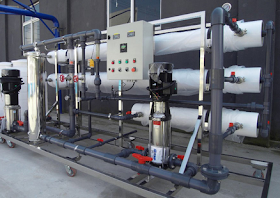To control microbial growth, RO systems must be chemically sanitized on a regular basis. Prior to sanitation, it is important to chemically clean the first-pass RO system. This will help to disrupt any biofilm that protects viable bacteria from contact with the sanitant. It also removes foulants that will react with and chemically deplete the sanitizing agent.
Typically this is done in a two-step process. The first step commonly involves the use of an acid cleaner such as citric acid to remove the inorganic foulants. Next, a high-pH cleaner such as sodium hydroxide is used in order to remove organic foulants.
Then the system is sanitized with one of the following agents: formaldehyde, hydrogen peroxide, or peracetic acid/hydrogen peroxide. It is important to consult the manufacturer of the RO system to determine the correct concentrations of the chemicals that are compatible with the membranes in the system and always rinse with Purified Water before changing chemicals.
Both cleaning and sanitation processes consist of four steps. First, the cleaning chemical is mixed with permeate water in a clean-in-place (ClP) tank. Second, the chemical solution is recirculated through the RO system for 15 to 30 minutes. Then, the system is left to soak for 20 to 30 minutes. The system should be started once every 5 to 10 minutes for a short time to allow the fresh solution to contact the membrane. Finally, the system should be rinsed with permeate water until the residual cleaning and/or sanitation chemicals have been removed.
Although the second pass of the RO does not typically require cleaning as frequently as the first pass, a regular cleaning and sanitation schedule should be maintained. This schedule should be based on the microbial concentrations and samples collected from the permeate water from the second-pass RO machine. When microbial concentrations in the permeate begin to rise steadily, sanitation should be conducted.
If peracetic acid or hydrogen peroxide are used to sanitize PA membranes, the membrane must be cleaned with an acid cleaner in order to remove free iron and any other transitional metals; otherwise, the membrane may be chemically damaged by the sanitation procedure. It is also important to make certain that the sanitant is mixed with water that is free of chlorine. The membrane's exposure to the sanitant should not exceed one hour per week at the recommended concentration level, or reduced membrane life may occur.
Biofilm Removal
Biofilm is a common term used to describe the accumulation of micro-organisms and their by-product excretions onto surfaces of a water treatment system. Because most micro-organisms prefer to become attached to a surface, more and more micro-organisms will adhere to the surfaces of a water system. As micro-organisms die, they become nutrient sources for other micro-organisms.
Over time, a film consisting of living and dead organisms will form. A slimy cover called a glycocalyx surrounds the organisms and serves to trap nutrients from the water source and protect the organisms from chemical destruction and biofilm removal.
For biofilm removal, it is necessary to conduct a series of sanitation and cleaning steps. First, inorganic should be removed using a low-pH cleaner. Second, any organic compound or dead micro-organisms should be removed using a high-pH cleaner such as sodium hydroxide. Third, a sanitation should be conducted using a common sanitizing agent such as formaldehyde, chlorine, or peracetic acid/hydrogen peroxide.
Then conduct a series of organic cleaning cycles followed by sanitation cycles. Prior to changing chemicals, always flush with purified water. For severe, established biofilms, it may be necessary to repeat this process 5 to 10 times. During each step, the sanitation agent should be in contact with the system for 15 to 30 minutes


You shared such a wonderful information. I bookmarked this blog further more information. Keep it up.
ReplyDeleteWater Treatment Calgary
Is it safe to use formaldehyde for cleaning? It is no more used for fumigation also.
ReplyDeleteThanks for sharing this valuable information. Best wishes
ReplyDeletegood information Ankur.
ReplyDeletewhat do u mean by dead volume?
ReplyDeleteHow often does one need to chemically clean the RO USP? Is this on a weekly, monthly, quarterly or annual basis?
ReplyDeleteClean RO quarterly at a minimum. But, your data (control charts) should tell you when to run a sani when needed more frequently
ReplyDelete